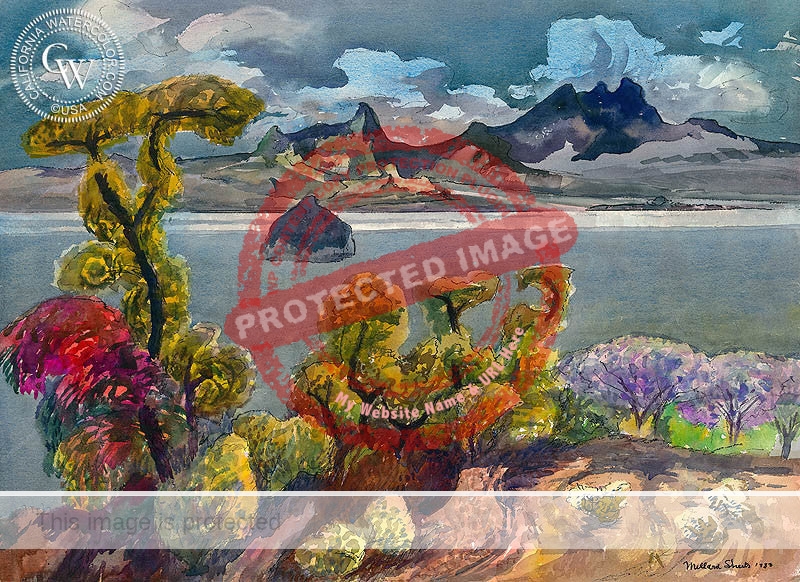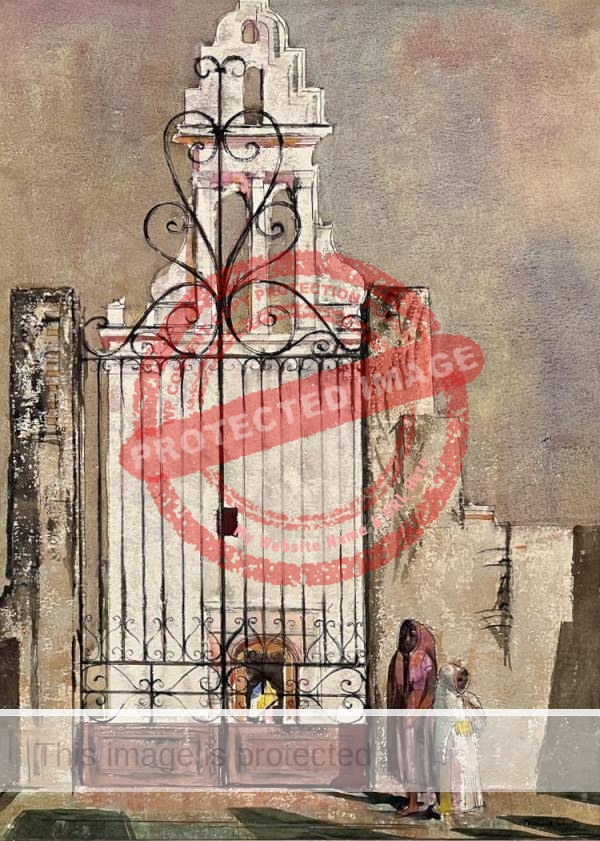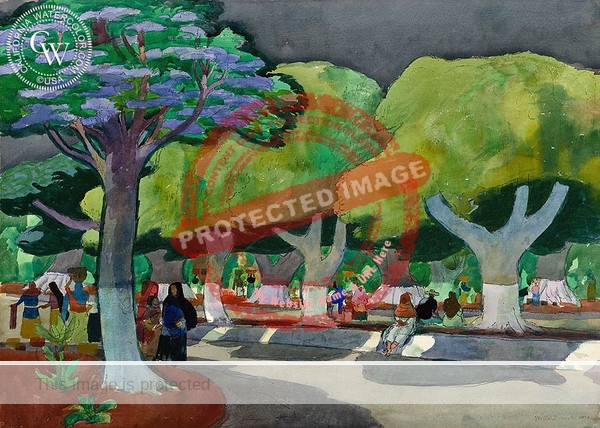Renowned American painter, educator, designer and architect Millard Owen Sheets was born in Pomona, California, on 24 June 1907, and died in Anchor Bay, California, on 31 March 1989.
Details of his biography are readily available online, at Wikipedia and at the website of the California Watercolor gallery.
But, in summary, Sheets studied at the Chouinard Art Institute, where, even before graduating, he was exhibiting watercolors in the annual shows of the California Water Color Society and teaching watercolor techniques at Chouinard.

Millard Sheets. 1983. Lake Chapala, Mexico. Reproduced by kind permission of California Watercolor gallery.
Note: Giclées of this painting are available via the website of the California Watercolor Gallery
He exhibited widely across the U.S. and Europe, and gained national recognition as a fine watercolorist. His life, work and painting style made the pages of Art Digest, Eyes on America and a book published by Dalzell Hatfield in Los Angeles in 1935.
During the second world war, Sheets was an artist-correspondent for Life magazine and served with the United States Army Air Forces in India and Burma.
As an art educator, Sheets worked at Chouinard Art Institute, Scripps College, and was Director of Otis Art Institute (1953-1960), fomenting the development of hundreds of young artists.

Millard Sheets. Chapala Church. (EBay photo)
Later in life he designed and executed dozens of major mosaic and mural projects. His commissions ranged from Los Angeles City Hall to Detroit Public Library, the Mayo Clinic, the mosaic dome and chapel at the National Shrine in Washington DC, and the Hilton Hotel in Honolulu, Hawaii.
Works by Sheets are in the permanent collections of many major museums, including the Metropolitan Museum of Art and the Whitney Museum (both in New York; the Chicago Art Institute; the National Gallery (Washington D.C.); the DeYoung Museum (San Francisco); and the Los Angeles County Museum.
Sheets made multiple visits to Chapala between 1947 (believed to be the first time he visited the lake) and the early 1980s.

Millard Sheets.1979. Noon, Chapala. Reproduced by kind permission of California Watercolor gallery.
Note: Giclées of this painting can be purchased on the website of the California Watercolor Gallery
Sheets’ 1947 trip to Chapala was in the company of long-time friend Merritt (‘Muggs’) Van Sant (1898-1964) and fellow artist, master woodworker and designer Sam Maloof (1916-2009), who was working for Sheets at the time and had learnt Spanish as a child from a Mexican-born housekeeper. Interviewed in 2002 by Mary MacNaughton for the Archives of American Art, Maloof recalled, albeit all too briefly, their trip to Chapala:
“… we flew to Guadalajara and I could have stayed for three years for what it cost us for three weeks. Of course it had to be the best hotel rooms and I had a room by myself. Millard and Muggs Van Zandt [Sant] had a room together and we had to rent a car. They had a brand new Buick with a driver that drove us all over and we’d all put money in the kitty every morning and Muggs would be the banker and we traveled from Lake Chapala to Morelia.”
Katie Goodridge Ingram (who first brought Millard Sheets’ link to Lake Chapala to my attention) remembered Sheets bringing an artist group to paint in Ajijic on at least one occasion.
Note: This is a work in progress. If you can offer any additional information about Millard Sheets’ visits to Lake Chapala, please get in touch!
Several chapters of Foreign Footprints in Ajijic: Decades of Change in a Mexican Village offer more details about the history of the artistic community in Ajijic.
Source
- Mary MacNaughton. 2002. Interview of Sam Maloof conducted January 2002 by Mary MacNaughton, for the Archives of American Art, in Maloof’s home/studio in Alta Loma, California.
Comments, corrections or additional material related to any of the writers and artists featured in our series of mini-bios are welcomed. Please use the comments feature at the bottom of individual posts, or email us.
Tony Burton’s books include “Lake Chapala: A Postcard History” (2022), “Foreign Footprints in Ajijic” (2022), “If Walls Could Talk: Chapala’s historic buildings and their former occupants” (2020), (available in translation as “Si Las Paredes Hablaran”), “Mexican Kaleidoscope” (2016), and “Lake Chapala Through the Ages” (2008).
I enjoy these posts very much. I don’t have a connection to Lake Chapala, myself, but through my late inlaws Lez & Eleanor Haas, which is how I got on the list. Thanks for keeping this up!
Thanks! You have no idea how grateful I am that you and others are enjoying reading the ongoing results of this project.
again–great info–thanks